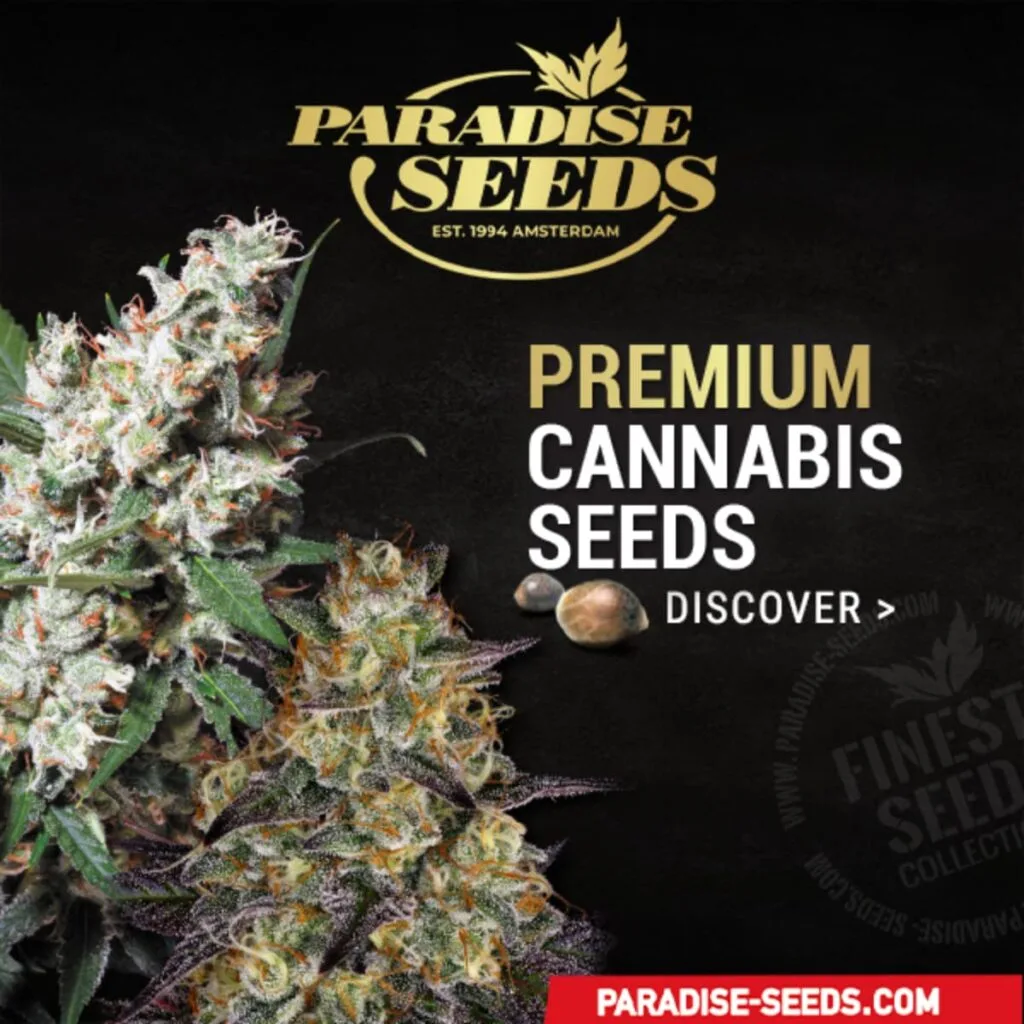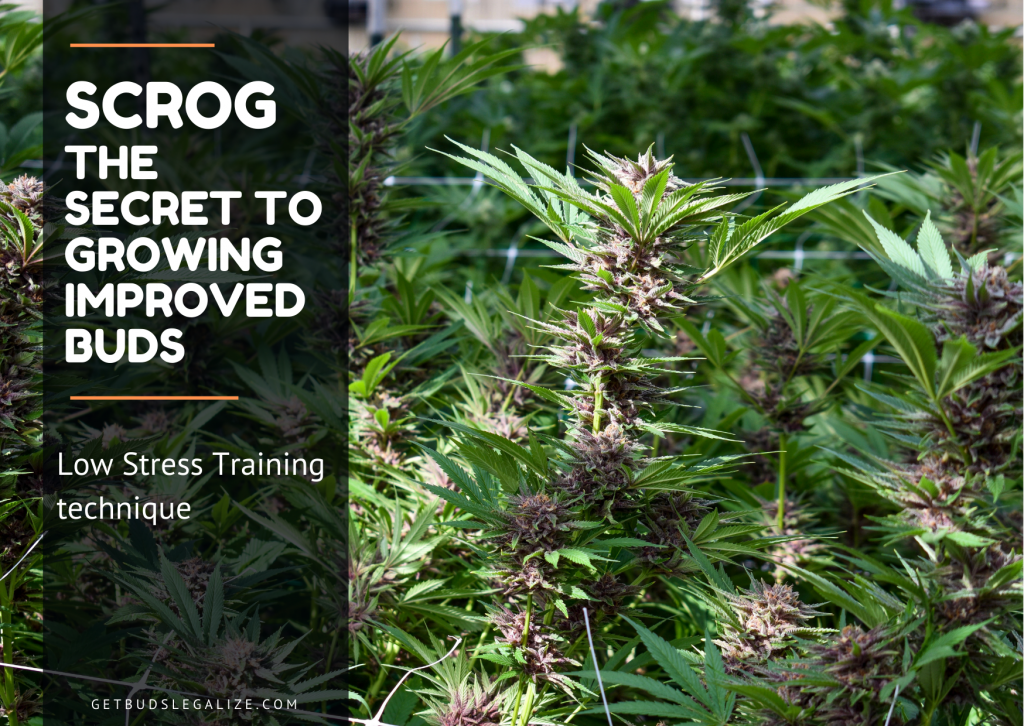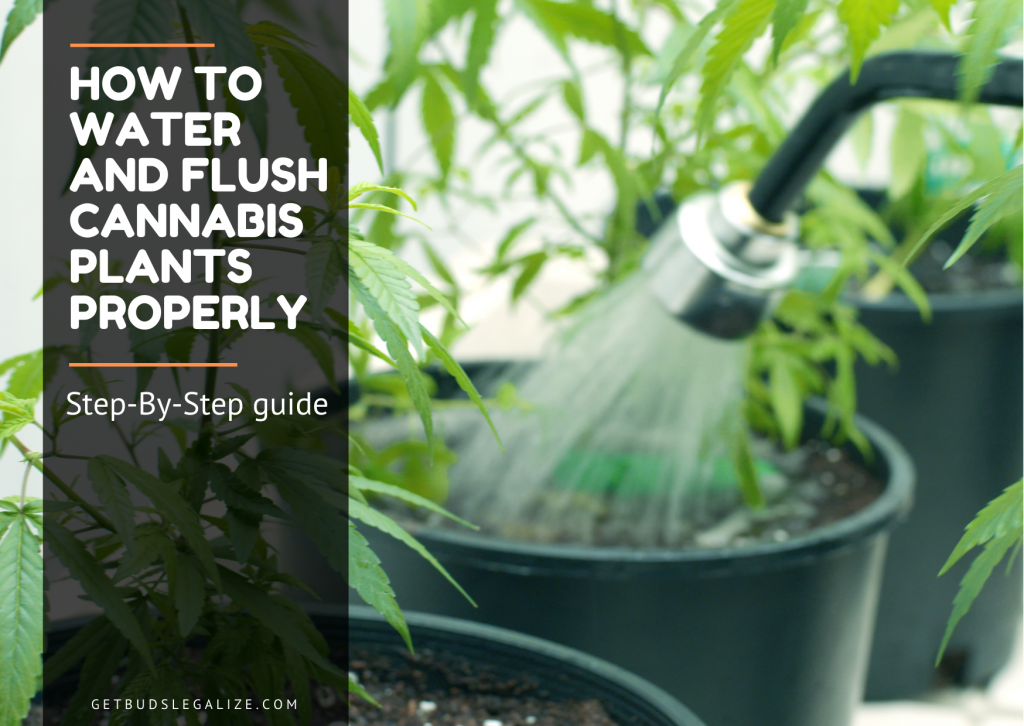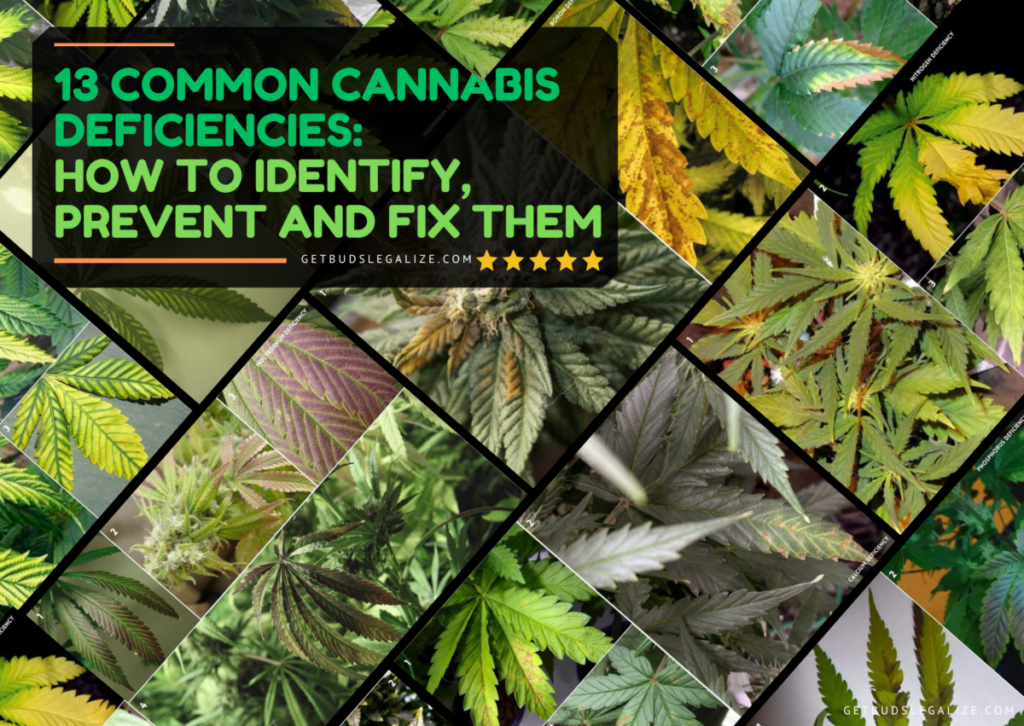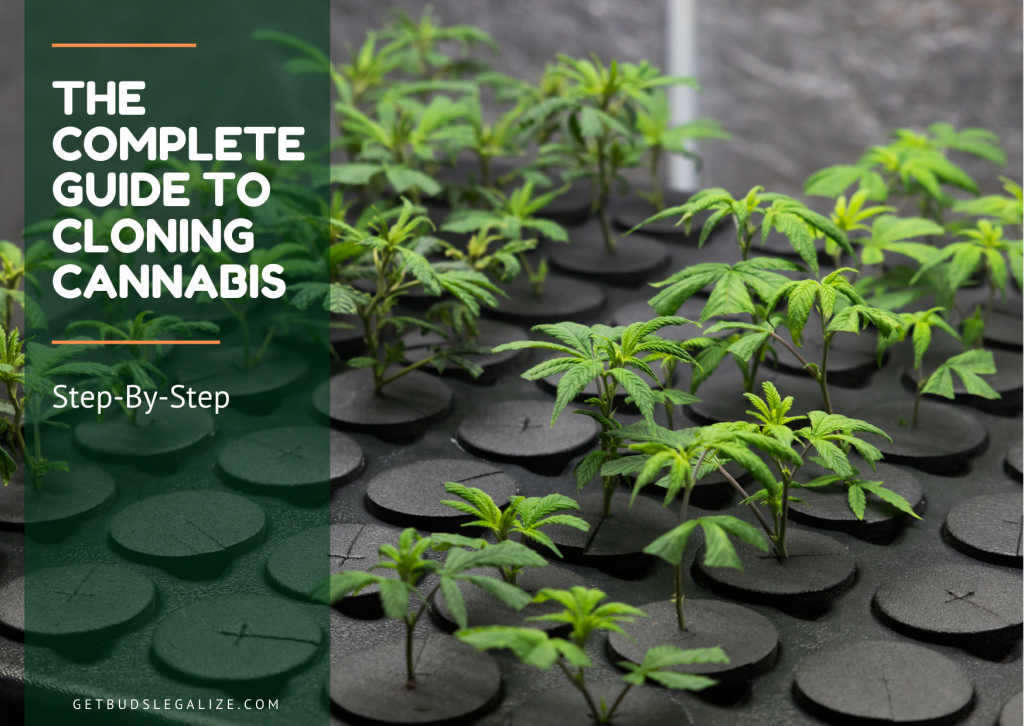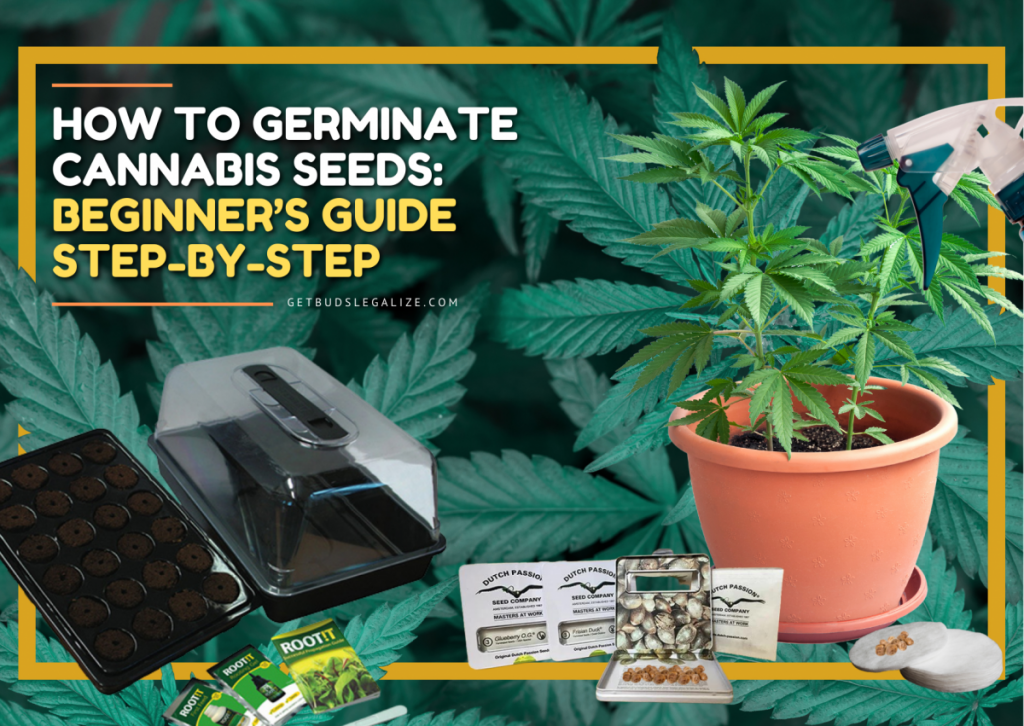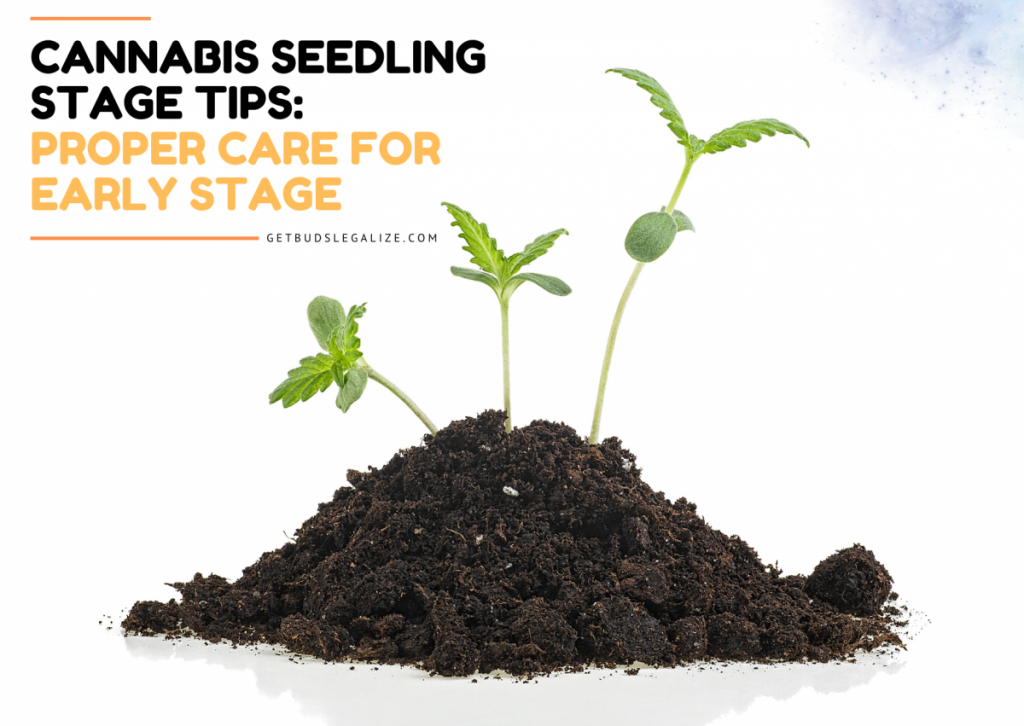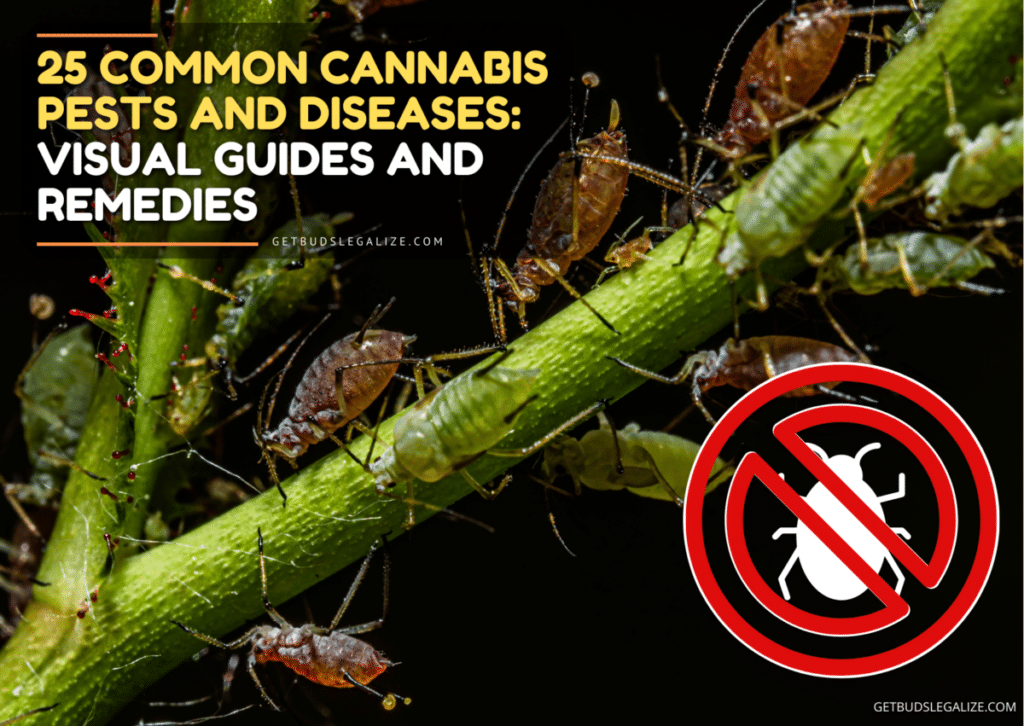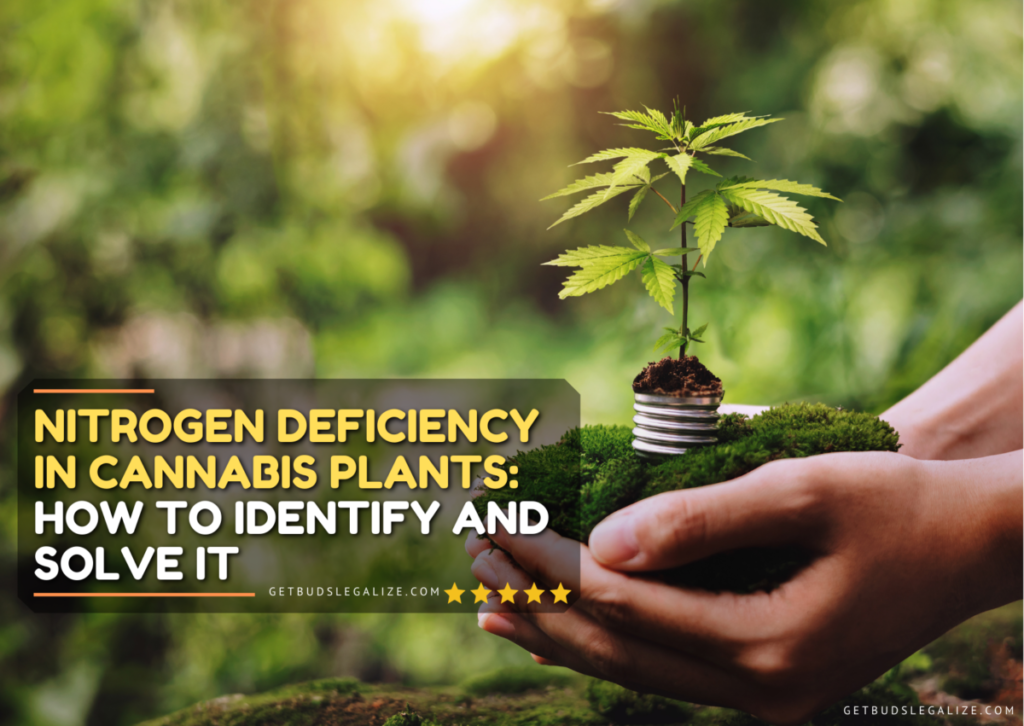How Much Space Does It Take to Grow Cannabis?
If you are thinking about growing your own cannabis, one of the first questions you might have is how much space you need. The answer is not simple, as there are many factors that affect the number of plants you can grow in a given area. In this blog post, we will explore some of these factors and give you some guidelines to help you plan your indoor cannabis cultivation.
What Are The Factors That Determine The Number of Cannabis Plants You Can Grow?
1. The Marijuana Strain
One of the first things to consider is the strain of cannabis you want to grow. Different strains have different characteristics, such as height, shape, flowering time, and yield. Some strains are more suitable for indoor than others, as they are more compact, fast-flowering, and easy to manage.
For example, indica and autoflowering strains tend to be shorter and bushier than sativa and photoperiod strains, which can grow tall and lanky. Therefore, if you have limited space, you might want to choose an indica or an autoflowering strain that can fit in your grow tent or room.
2. The Size of Your Indoor Grow
Obviously, the size of your grow tents or room will limit the number of cannabis plants you can grow. The bigger the space, the more plants you can fit. However, it would be best if you also considered other factors such as ventilation, humidity, temperature, and light distribution. You don’t want to overcrowd your plants and create a favorable environment for pests and diseases.
A good rule of thumb is to leave at least 30 cm (12 inches) of space between each plant. This will allow enough airflow and light penetration for optimal growth. You can also use a tape measure or a grid to calculate how many plants you can fit in your space.
3. The Pot Size
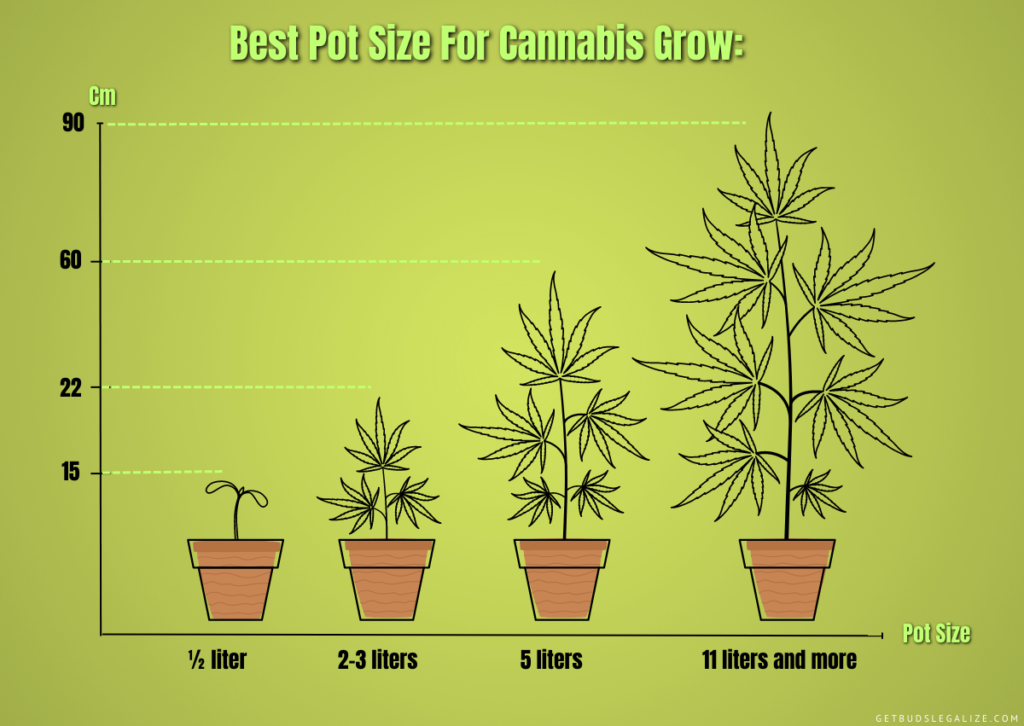
The size of your pots is an important factor that affects how many marijuana plants you can grow per square meter, as well as how big they will grow. In other words: The bigger your pots, the bigger your plants will be.
Here are some guidelines for pot sizes:
- ½ liter: Suitable for seedlings and young plants up to ~15cm
- 2–3 liters: Ideal for plants up to ~25cm
- 5 liters: Good for plants up to 60cm
- 11 liters and more: Average plant size
For a typical grow indoor, you can fit nine 11-liter pots per square meter.
Use rectangular pots to make the most of your available space. Round pots will leave gaps and waste space.
The size of your pots should match the size of your plants and the length of your vegetative growth. If you plan to grow small plants with a short veg time, you can use smaller pots (3-5 liters). If you plan to grow bigger plants with a longer veg time, you can use bigger pots (10-20 liters).
4. The Growing Method
The growing method you choose will also influence the number of plants you can grow. There are two main methods: soil and hydroponics. Soil is the traditional way of growing cannabis, where you use soil or a soilless mix as a medium for your plants. Hydroponics is a method where you use water and nutrients as a medium for your plants.
Soil is easier and cheaper to set up, but it takes up more space and requires more maintenance. Hydroponics is more expensive and complex to set up, but it saves space and allows for faster growth and higher yields.
The number of plants you can grow in soil or hydroponics depends on the type of system you use. For example, in soil, you can use regular pots or smart pots that allow for better drainage and aeration. In hydroponics, you can use different systems such as drip irrigation, ebb, and flow, deep water culture (DWC), or aeroponics.
Each system has its own advantages and disadvantages, so you need to do some research before choosing one.
5. The Training Techniques
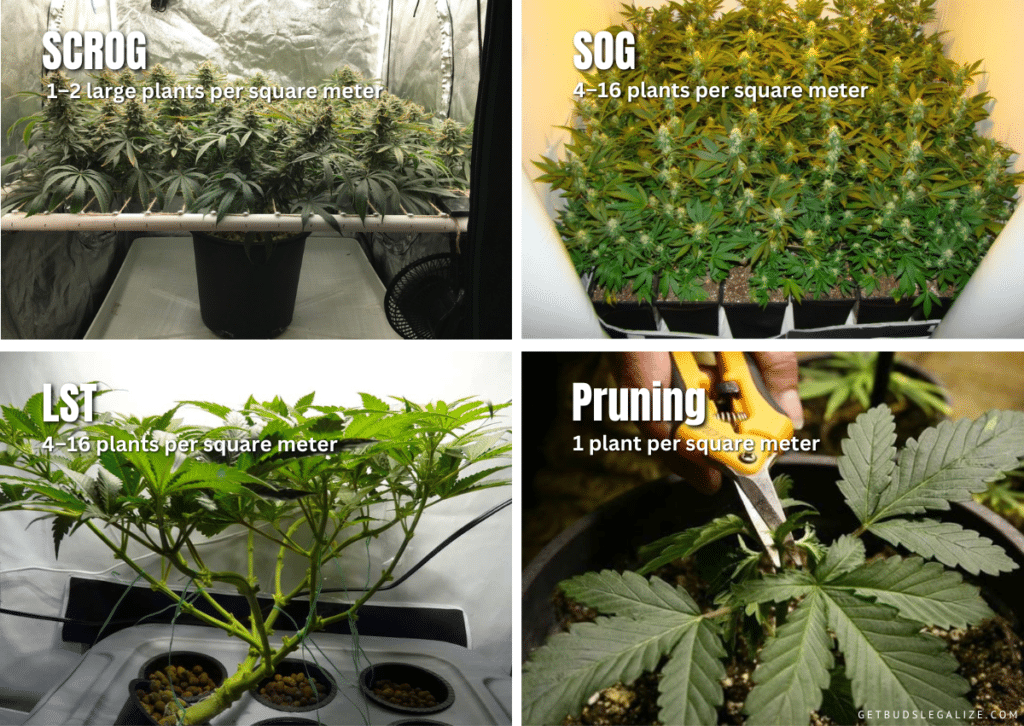
The training techniques you use will also affect the number of plants you can grow. Training techniques are methods of manipulating the shape and structure of your plants to improve their light exposure, airflow, and yield. There are many types of training techniques, such as topping, fimming, mainlining, lollipopping, low-stress training (LST), and screen of green (SCROG). Each technique has its benefits and drawbacks, as well as its optimal plant density.
Here are some examples of training techniques and their recommended plant density per square meter:
• Sea of Green (SOG):
This technique involves growing many small plants that are harvested early without any training. This way, you can achieve a quick turnover and a uniform canopy. However, this technique also requires more seeds or clones, more pots, more water and nutrients, and more trimming. The recommended plant density for SOG is 4–16 plants per square meter.
• Topping and Fimming:
These techniques involve cutting off the top of the main stem or a branch to create two or more new branches. This way, you can increase the number of colas (flowering sites) and create a bushier plant. However, these techniques also cause stress to the plants, slow down their growth, and increase the risk of infections. The recommended plant density for topping and fimming is 2–4 large / 4–8 medium plants per square meter.
• Mainlining and Lollipopping:
These techniques involve creating a symmetrical structure with multiple colas of equal size and height by pruning all the lower branches and leaves. This way, you can maximize the light efficiency and the yield per plant. However, these techniques also require a lot of time and skill, as well as a longer vegetative phase. The recommended plant density for mainlining and lollipopping is 1 large / 2–4 small plants per square meter.
• Low-Stress Training (LST):
This technique involves bending and tying down the branches to create a flat and wide canopy. This way, you can expose more buds to the light and increase the yield per plant. However, this technique also requires more space and maintenance, as well as careful monitoring of the branches. The recommended plant density for LST is 2–4 large / 4–6 medium plants per square meter.
• Screen of Green (SCROG):
This technique involves using a net or a screen to train the branches horizontally. This way, you can create an even canopy that fills up the entire grow space and produces more buds per square meter. However, this technique also requires a lot of patience and attention, as well as regular trimming and tucking of the branches. The recommended plant density for SCROG is 1–2 large plants / 4 medium-sized plants per square meter.
6. The Desired Yield
The yield is the amount of buds that you harvest from your. The yield depends on many factors, such as the strain, the growing method, the lighting, the nutrients, the environment, and the training techniques.
The yield also depends on how many plants you grow. Generally speaking, more plants mean more buds, but this is not always the case. Sometimes, fewer plants can produce more buds if they are grown well and trained properly.
The yield also depends on your expectations and needs. How much cannabis do you want to harvest? How much cannabis do you consume? How often do you want to harvest? These are some questions that you need to ask yourself before deciding how many plants to grow.
7. The Grow Lights You Use
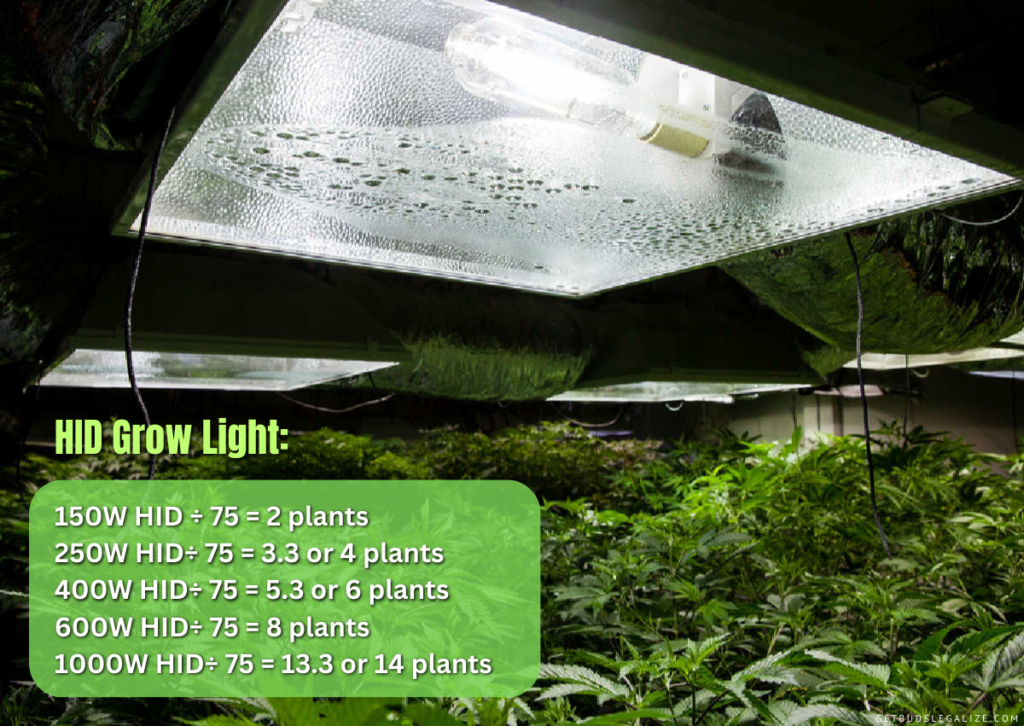
The lights you use will also affect the number of plants you can grow. The grow lights are the main source of energy for your plants, so they need to be powerful enough to cover your entire grow space and provide enough light intensity and spectrum for optimal growth.
There are different types of lights that you can use, such as:
- High-Intensity Discharge (HID) Lights: These are the most common and popular lights for growing marijuana. They include metal halide (MH) and high-pressure sodium (HPS) bulbs. They produce a lot of light and heat, but they also consume a lot of electricity and require a ballast, a reflector, and a cooling system.
- Light-Emitting Diode (LED) Lights: These are the most advanced and efficient light for growing marijuana. They produce a full spectrum of light with minimal heat and power consumption. They are also easy to install and adjust but more expensive than HID lights.
- Fluorescent Lights: These are the cheapest and easiest lights for growing marijuana.. They include compact fluorescent lamps (CFL) and T5 tubes. They produce a cool spectrum of light with low heat and power consumption. They are ideal for seedlings, clones, and small plants, but they are not powerful enough for flowering.
The number of plants you can grow under each type of light depends on the wattage and the coverage area of the light. A good rule of thumb is to divide the wattage by 75 to get the number of plants you can grow under HID lighting. For example:
- 150W ÷ 75 = 2 plants
- 250W ÷ 75 = 3.3 or 4 plants
- 400W ÷ 75 = 5.3 or 6 plants
- 600W ÷ 75 = 8 plants
- 1000W ÷ 75 = 13.3 or 14 plants
For LED and fluorescent lights, you need to check the manufacturer’s specifications for the coverage area and the recommended distance from the plants.
8. Legal Regulations
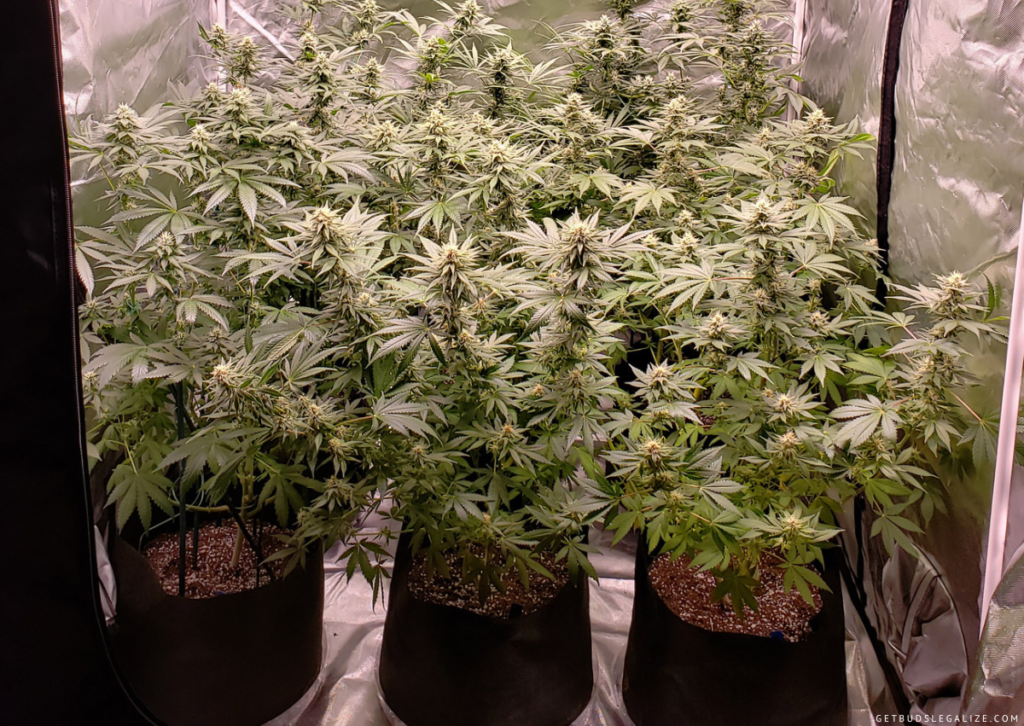
Another factor that you need to consider when deciding how many plants to grow is the legal regulations in your area. Depending on where you live, there might be laws and restrictions that limit the number of plants you can grow or the amount of cannabis you can possess.
You need to be aware of these laws and follow them to avoid any legal troubles or penalties. You also need to be discreet and secure your grow room to prevent any unwanted attention or theft.
Don't Forget the Environment
Finally, you need to remember that growing weed is not just about planting seeds and harvesting buds. You also need to monitor and control the environment in your grow space to ensure optimal conditions for your plants.
You need to check and adjust the temperature, humidity, ventilation, pH, EC, CO2, and other factors that affect your plants’ health and growth. You also need to water, feed, prune, train, and protect your plants from pests and diseases.
Cannabis growing is a rewarding hobby, but it also requires time, effort, money, and knowledge. You need to be prepared and dedicated to achieving the best results.
Final Thought
As you can see, there is no definitive answer to how much space it takes to grow weed or how many plants you can grow in a given area. It depends on many factors that vary depending on your situation and preferences.
However, by following some general guidelines and doing some research, you can plan your indoor growing accordingly and optimize your space and resources.
We hope this blog post has been helpful and informative for you. If you have any questions or comments, feel free to let us know through our social networks, we will be more than happy to answer them. Happy growing!
FAQs - How much space does it take to grow cannabis
The space per cannabis plant depends on how big you want your plants to be and how much yield you want to get. Generally, you can use the rule of thumb of 1 plant per sq ft, but you can also adjust this according to your preferences. For example, if you want your plants to grow bigger with more buds, you can give them more space, such as 2 or 3 sq ft per plant. If you want smaller plants with less maintenance, you can give them less space, such as 0.5 or 0.75 sq ft per plant.
Assuming you use a standard 1 plant per sq ft yield, you can grow up to 1000 plants in a 1000 sq ft area. However, this may vary depending on the strain, the growing method, and the environmental conditions.
A 20’x20 room is equivalent to 400 sq ft, so you can grow up to 400 plants in this space. Again, this is a rough estimate and may change depending on other factors.
If you want to grow only 4 plants, you don’t need a large grow room. You can use a small grow tent that measures 2’x2’x5′, providing enough space for 4 plants to grow comfortably.
A 4×4 tent is one of the most common sizes for indoor, as it can fit in most closets or spare rooms. The number of plants you can grow in a 4×4 tent will depend on the size of the pots and the training techniques you use.
Generally speaking, you can grow anywhere from 4 to 16 plants in a 4×4 tent, depending on how much space you want to give each plant. For example, if you use 5-gallon pots and top your plants to create a bushy canopy, you can fit about 9 plants in a 4×4 tent. If you use 3-gallon pots and use a screen of green (SCROG) method to spread your plants horizontally, you can fit up to 16 plants in a 4×4 tent.
The amount of light you need for your indoor garden will depend on the size of your space and the type of light you use. Generally speaking, you want to provide at least 50 watts per square foot of growing area for optimal growth and yield. For example, if you have a 4×4 tent, you will need at least 800 watts of light to cover the entire area.
However, this is just a general guideline, and different types of lights may have different efficiencies and outputs. For example, LED lights are more efficient and produce less heat than HID lights, so you may need less wattage to achieve the same results. The best way to determine how much light you need is to measure the light intensity at different points in your growing area using a lux meter or a PAR meter.
Ventilation is essential for maintaining a healthy environment for your plants, as it helps to regulate temperature, humidity, and carbon dioxide levels. The amount of ventilation you need for your indoor garden will depend on the size of your space, the type of lighting, and the climate outside.
Generally speaking, you want to exchange the air at least once every minute. For example, if you have a 4×4 tent with a volume of 64 cubic feet, you will need a fan that can move at least 64 cubic feet per minute (CFM) of air. However, this is just a general guideline, and you may need more or less ventilation depending on other factors.
For example, if you use HID lights that produce a lot of heat, you may need more ventilation to keep the temperature down. If you live in a humid area, you may need more ventilation to prevent mold and mildew. The best way to determine how much ventilation you need is to monitor the temperature and humidity in your growing area using a hygrometer or a thermometer.
ILGM Fertilizer
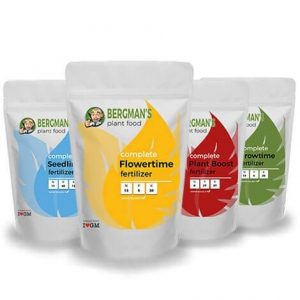
- From seedling to harvest, give your plants everything they need.
- Enough for feeding at least 5 plants.
- Discounted Package Deal
- Works well in soil, hydroponics, and other growing mediums.
- The best way to treat your plants
ILGM Plant Protector
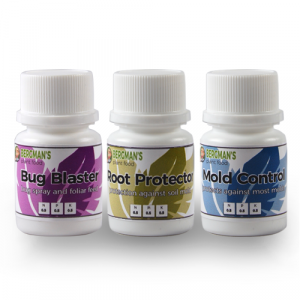
- Protect your cannabis from diseases and harmful pests.
- Contains three 20 ml bottles.
- Enough supplies to protect 20 plants.
- It can be used in soil, hydroponic, and all other growing mediums.









